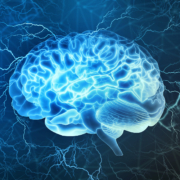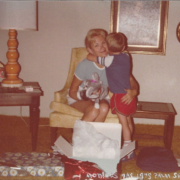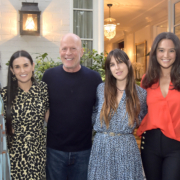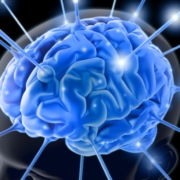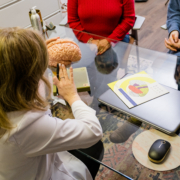Broadening the understanding of Alzheimer’s Disease
As Vice President of Medical and Scientific Relations for the Alzheimer’s Association, Dr. Heather Snyder oversees association funding initiatives that accelerate innovative Alzheimer’s and dementia research, and provides opportunities for the global dementia community to connect and collaborate. Dr. Snyder leads the Association’s International Research Grant Program. She also provides leadership on several of the Association’s cutting-edge scientific initiatives. The National Academy of Neuropsychology (NAN) works closely with Dr. Snyder and the Alzheimer’s Association to promote research and education around dementia. BrainWise Managing Editor, Matt Villano, recently sat down with Dr. Snyder to learn more about the Alzheimer’s Association’s approach to research, and where neuropsychology fits in. What follows is an edited transcript of their conversation.
BrainWise: What is the biggest misconception about Alzheimer’s Disease?
Dr. Heather Snyder: When somebody says, ‘Where do you work? What do you do?’ I share that I’m one of the scientists on staff at the Alzheimer’s Association, and often the response is, ‘Oh, my mother (or my grandmother) had dementia. She didn’t have Alzheimer’s though.’ One of the most common questions or comments we get is this lack of understanding that Alzheimer’s is a disease that causes dementia. But there are other diseases that cause dementia: frontotemporal disorders, for instance, Lewy Body disease, Parkinson’s disease, vascular and cerebrovascular disease, and more. Dementia is the umbrella term that describes the symptoms a person experiences, including changes in memory, thinking, and reasoning. As we understand more and more about the diseases that cause these memory changes, it creates an opportunity for us to say, ‘When did those changes start happening?’ From there, we can ask, ‘When and how can we intervene?’ [These questions enable] us to [start] talking about early and accurate diagnosis, early treatment, and prevention that will get us to a place of being able to stop and ultimately cure these diseases.
I want to emphasize the importance of having accurate and early diagnoses. It’s vitally important to know what is causing somebody’s memory to change. As we expand our toolbox of treatments [and] interventions, [we think] about behavioral interventions, medications, and the combinations of all those things that are really addressing the individual’s underlying biology. We do this in oncology with personalized medicine and personalized treatments based on the stage of cancer, the type of cancer, and the specific genetics of that cancer; we personalize the treatment to the person. When we think about the diseases that cause dementia, understanding that biology and then personalizing the treatment is ultimately the goal.
BrainWise: What are some of the most prominent initiatives being sponsored by the Alzheimer’s Association, and how are they making an impact?
Dr. Snyder: The Alzheimer’s Association is the world’s largest voluntary health organization dedicated to Alzheimer’s and other dementias. We have a very active public policy team. We are a community-based organization that provides care and support services in [individual] communities, [as well as] educational programs and other ways of linking [communities] to one another and to resources that will help individuals that have questions and/or are on [an Alzheimer’s] journey. The Association also is the world’s largest nonprofit funder of Alzheimer’s and dementia science. We currently have around $405 million that’s active and committed to more than 1,100 projects in 56 countries. That number continues to grow with the investments that we make in all areas of research.
We fund the entire spectrum of science, such as understanding how proteins are working in a cell, [investigating] the implications of a particular gene all the way through clinical trials, developing tools for early and accurate diagnosis or diagnosis across the entire disease, and [studying] the best types of care interventions. [We also look at] how to measure [interventions], and how to deliver them to ensure people have the best quality of life.
We recognize it’s important to go beyond the funding by supporting the workforce and supporting the research community, from graduate students all the way through more established researchers and leaders in our space. Some of that is by bringing researchers together: the Alzheimer’s Association International Conference (AAIC) is the world’s largest convening of dementia science. We take an annual look at what’s happening, what have we done well, where are the gaps, where do we need to focus, where do we need to go, and what are the wins that we can then build upon going forward.
We have a professional society called the International Society to Advance Alzheimer’s Research and Treatment (ISTAART), which is an opportunity for scientists to come together around topics of shared interest. For instance, there’s a professional interest area (aka, PIA) that’s focused on neuropsychiatric symptoms—those truly challenging symptoms that we know individuals living with the disease and caregivers are dealing with. Things like apathy, agitation, and sleep disturbances. This group comes together and says, ‘What can we do? What are ways that we can better support studies in this space?’
Another one of the professional interest areas is looking at the intersection of Down syndrome and Alzheimer’s disease. We know people with Down syndrome are at an increased risk for Alzheimer’s because of the triplication of chromosome 21. We also see triplication of a gene called the amyloid precursor protein. We see the overproduction of beta amyloid in these individuals from a very early age, and we see those changes that are associated with Alzheimer’s in the brain at a very early age. We aim to advance the understanding of this intersection and how we can potentially translate the findings. This is an example of how we’re moving the field forward to ensure that research is making the progress that is so needed for all our families and communities.
BrainWise: In what ways do you see how not only income disparities but gender and cultural differences are affecting how practitioners assess and treat dementia in different countries?
Dr Snyder: When we talk about health equity, it’s important to see the bigger picture as well as individual impact, and to think about intentional inclusion. At the Alzheimer’s Association, we focus on intentional inclusion across all areas of our mission, ensuring we are meeting communities with the resources they say are needed. We constantly examine how we are moving science forward [in a way that is] intentionally inclusive, and how we are delivering care and support services that are culturally relevant and effective.
As we look at the total landscape of Alzheimer’s and dementia science, there [have] been some significant advances in tools for early diagnosis, [such as] taking pictures of the brain through advanced imaging and progress on verifying the accuracy of blood tests. We had the first FDA approved treatments that change the course of the disease in just the last two years. As all that work goes forward, we must also assure that it is translatable, accessible, and effective for all communities.
I think that’s where that personalized medicine approach comes in. We know that for Alzheimer’s and other dementia there is a disproportionate impact for Black/African American individuals and Hispanic/Latino/Latinx individuals, and for women. We know that women are at greater risk or are more likely to be living with Alzheimer’s than men. Two-thirds of those who are living with this disease are women. A big question is, ‘Why?’ In 2015, the Alzheimer’s Association convened a group of experts to ask [some important] questions. Is the science there? Is there something more than [a longer lifespan] that could explain this difference? We came out of those two days with many, many more questions than we had answers. From that we launched the first dedicated funding call in this space. We’ve just completed a second dedicated funding call, as we continue to understand more about biological sex and how it might be contributing to changes in the disease.
To effectively do this work, we’ve built solid relationships with trusted partners in communities across the country. We’ve been working with more than 30 national partners and more than 600 local organizations to provide education, offer support, invite people to join the cause, and move the cause forward. We’ve increased our ability to reach and engage all populations in a way that matters. We’ve heard from the communities [about what] is important to them. We can understand the big picture [like never before].
BrainWise: Where is the bleeding edge as far as the research is concerned here? When you look at disparities, how the Association is working to bridge these gaps, what areas or projects are you most excited about when you look at that broader issue?
Dr. Snyder: One of the studies that the Association supports is called the U.S. POINTER Study, which is looking at lifestyle/behavioral interventions that target multiple components of risk in a population of individuals that are thought to be at increased risk for cognitive decline. This study includes more than 2,000 individuals age 60 to 79, at five sites across the United States. We were very committed—since the very beginning of this study—that the study population would be representative of the communities that we were based in. I’m proud to say that about 31 percent of our participants are from historically underrepresented populations. In addition, we’re committed to sharing the data that comes out of that study more broadly, and that there is an opportunity to ask questions in ways we haven’t been able to before because our studies haven’t been representative.
BrainWise: On another subject, how can technology improve the lives of individuals living with Alzheimer’s, particularly as they go about their lives at home?
Dr. Snyder: Often, we hear from individuals about the desire to be able to do what they want to do longer. Creating tools—analog, digital or whatever—that allow them to maintain that independence [for a] longer [time] is crucial. This might be different for each person. For example, some people live with several other people in their house, other people live alone, and so ensuring that we have technologies that are adaptable based on an individual’s living situation is important. There also has been some work that looks at leveraging existing technologies such as the smartphone. Anecdotally, what we hear from people is these types of tools [can be] incredibly helpful in allowing them to do what they want to do longer, and that’s really the goal.
Right now, the Alzheimer’s Association is very focused on real-world data. As we collect real-world data from different care settings and different clinical settings for an individual, how can we utilize that data in the big picture to improve diagnosis, treatment, and care? If you can start to apply different algorithms and different understandings, what types of treatments might be most beneficial for an individual, or what combinations of treatments? This is how the cancer space has rapidly advanced. As they’ve collected real-world data on tumors and different treatments, it has grown our understanding about how to better personalize the interventions. We know there have been studies, for instance, that have shown that being physically active makes a particular chemotherapy agent more effective. Thinking about those kinds of learnings, adding technology onto the real-world data we’re collecting, we’re moving our field forward. In my mind, this all fits in that space of how we use technology to help people with Alzheimer’s.
I know there’s a lot that we’re going to learn in the coming years. Hopefully, artificial intelligence will allow us to identify people at the earliest stage so we can intervene in the best way possible. It’s an incredibly exciting time that’s moving us forward at an accelerated pace. And we see this in real time at AAIC each year. We have a one-day workshop at the conference that covers the intersection of dementia and technology, and the topics are varied.
BrainWise: As kids of Baby Boomers prepare to care for our parents, how can the Alzheimer’s Association step up and step into a role where that education becomes more pervasively helpful even for families that aren’t maybe grappling with an Alzheimer’s diagnosis just yet?
Dr. Snyder: It comes back to being present in the community and ensuring that the resources and information that’s being shared is what the community sees as their need, and helping to outline what may be the needs in the future. It’s about ensuring that we are genuinely meeting the community and each individual in a way that is impactful and meaningful for them.
I’m the child of Baby Boomers and I have young children. I sit in a privileged position of having access to resources and information because I work at the Alzheimer’s Association. I think the mission of ensuring that our information is accessible and easily found in all communities is incredibly important. What’s normal aging and what’s not normal aging? And when might there be interventions that are going to help an individual? Who can help and guide the person on this journey? What’s available in my community? How can I contribute to ending this problem for future generations? A lot of this is simply starting and then continuing to be part of that conversation.
The Alzheimer’s Association brings together the Walk to End Alzheimer’s every year as one of the largest and most successful community activities that raise awareness and funds around Alzheimer’s. We are continuously engaged in new ways to raise awareness and raise our voices in this conversation more broadly. I participated in two walks this year with my children because we have a family history of Alzheimer’s, and I want to ensure that the future for them is different.
BrainWise: Where do you feel clinicians and other experts could stand to be more educated and more sensitized to some of the issues surrounding Alzheimer’s?
Dr. Snyder: It is amazing right now that Alzheimer’s science is moving so fast. Ensuring that we stay informed about the latest science is a challenge when you have a full patient load. Being able to respond to every study that’s published is a lot of extra work on an already very busy clinician. This is an issue that the Association is deeply invested in; we are providing clinicians with information in a way that is accessible and easy for them to apply. Plus, primary care physicians can direct patients with Alzheimer’s and their family members to the Alzheimer’s Association. Finally, with emerging and newly available treatments such as infusion therapies, [we want to guarantee that] clinicians have opportunities for educational programming—for themselves and for patients.
BrainWise: How important are neuropsychologists to the future of Alzheimer’s disease research and treatment?
Dr. Snyder: The expertise that neuropsychologists bring to the table with the different kinds of assessment tools is critically important. What are those subtle changes that an individual experiences? How do we interpret an individual’s test information, based on their circumstances? That’s an expertise that only neuropsychologists have. There are so many kinds of scales. Translating that into lived experience is a skill that the neuropsychology field emphasizes and has demonstrated expertise.
BrainWise: Overall, where do we go from here with Alzheimer’s research and advocacy?
Dr. Snyder: Whatever you’re able to do, you can be part of the solution. You can participate in your Walk to End Alzheimer’s and raise awareness in your community, you can volunteer more actively and teach classes or run a support group, you can be an advocate for this cause or you can participate in a clinical trial. [You also can] talk about your experience with your friends and family and neighbors so we continue to raise our voices about the importance of this issue. That opens the door for others to talk as well.
We work very closely with an incredible philanthropist and leader in Northern California, Michaela “Mikey” Hoag. Mikey started and has grown the Part the Cloud program to support early phase human clinical trials in Alzheimer’s, funding more than $65 million for 65 trials to date. Mikey says that by sharing her story, she now regularly has people calling her and asking her for where to go for information. Or they just want to take a walk and have someone to talk with because they’ve gone through this journey, too.
We all can be part of a support system in our community. I encourage everyone to get involved in whatever way works for them.
This article has been factchecked. For more about that process, click here.


